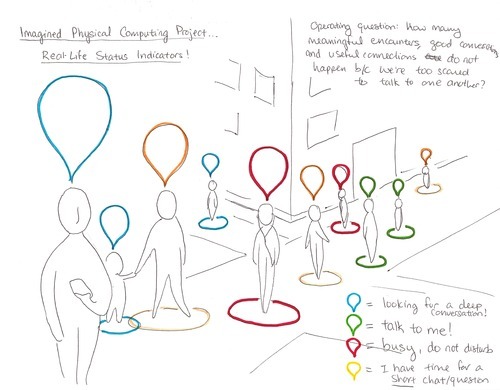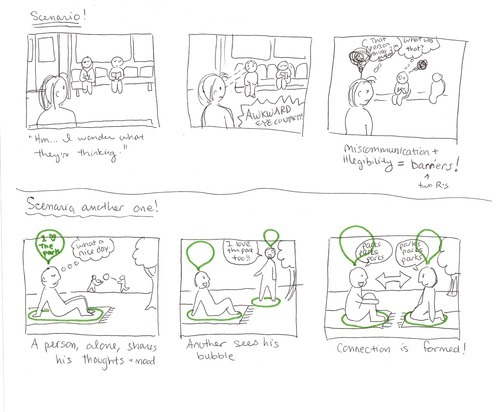Imaginary physical computing project…

… a way to talk to people you never knew you’d talk to.
Earlier this year, I was working on a startup idea with a couple of friends. The goal was to create a lifelike virtual world for learning foreign languages. Since the whole point of the world was to get strangers to talk to each other in a foreign language, and thereby practice it, we thought hard about how to get people to approach one another.
One of the ways we arrived at was the well-known status indicator. We already have these in familiar IM applications such as iChat and Google Talk. The difference in this language-learning world, however, would be the level of detail they can convey. We thought about mood icons; allowing short, Twitter-like thought messages; a more involved color-coding schematic, etc.
Well, the language learning MMO went the way of 99% of all startup ideas: it died for lack of funding. But the idea of using status indicators as a way to allow strangers to meet and make connections stuck with me.
My imagined physical computing project is essentially that, but in real life. The following sketches demonstrate what this might look like:


This would not be easy to implement. Obvious problems include getting over the perception of “creepiness.” Our culture doesn’t think highly of “stalkerly” behavior, even as we love to broadcast our lives to the world. Another problem would be physical implementation – what technology would we have to use to project a colored “bubble” over someone’s head, and a circle where they were sitting? Perhaps a bubble containing text even? How would the text be legible on both sides?
After coming up with this idea, I realized it doesn’t really fulfill one of the core tenants of physical computing, which is that it is a way for computers to sense the world and reacting to that sensory input. To make this more in keeping with true physical computing, rather than just being a glorified display technology, we could use a sensor to detect a person’s moods and willingness to be social. That would determine the color of the balloon automatically, instead of requiring the user to adjust it manually. It could also also cull status reports from their Twitter or Facebook account.